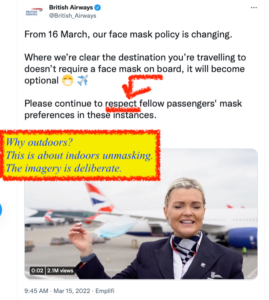In response to a thread on May 24, 2022, between Mr. Tom Jackman and Dr. Michael Schwandt, I decided to delve into the literature to point out the problematic messaging that has been coming from many governmental / public health bodies, including that in British Columbia.
The two-sentence summary: public health officials in much of the world were unprepared for COVID and have stumbled on messaging throughout the pandemic. We need them to stop emphasizing "feeling" and focus more on a public, fact-based and best-practice communications strategy.
Because it's hard to follow my response on Twitter, I've decided to post the whole thing here.
Hi, @MichaelSchwandt. We've never met, but I've been tagged in here and applaud you for engaging openly and in good faith. As a prof, I'm a big fan of using the literature and see the pandemic as an opportunity for fields like Public Health and Engineering to improve.
So, let's have a look at the literature.
The discourse over masking is complex. In Canada, and in much of the Western world, it predates COVID. Remember the niqab and Québec’s Bill 94 – all driven by cues from France? Much of the discussion was _also_ framed around “freedom”

The decision to mask or unmask has racial components. While I’m not from BC, my wife is and I spend a lot of time in the GVRD. There are tensions in BC between Asian and non-Asian groups. Any PSA that shows Asians in masks and whites without masks is playing into a trope.

The decision to mask or unmask is a political one. Many of us know that implicitly, and the literature backs this up.

The decision to mask or unmask is also gendered. See and Capraro and Barcelo, 2020 and Marcus in The Atlantic, 2020.


Many agencies, public health / government and commercial, have used similar imagery to announce the removal of masking protections. British Airways was panned for it (unmasking flight attendant tweet, March 15, 2022). The flight attendant appears to be outdoors when she unmasks. But the context is indoor unmasking. The outdoor imagery is preferred because it implies “fresh” air and “freedom”. The messaging would have been less effective had she unmasked in a cramped indoor environment like an airplane cabin. And the “respect” hammer against maskers is right there. It’s deliberate.
But the context is indoor unmasking. The outdoor imagery is preferred because it implies “fresh” air and “freedom”. The messaging would have been less effective had she unmasked in a cramped indoor environment like an airplane cabin. And the “respect” hammer against maskers is right there. It’s deliberate.
But it’s not just BA. It’s all over the place. A Google search finds the same thing in other contexts, with helpful stock footage.

Public Health officials are in a difficult position. They were unprepared for COVID and the “caught with their pants down” response to it has been broadly panned from all sides. The result is that trust in public health agencies has declined.

What is the way forward? One way is through better communication. (Azer and Alexander, Journal of Service Theory and Practice, 2022)
https://www.emerald.com/insight/content/doi/10.1108/JSTP-08-2021-0184/full/html
We saw public health agencies struggle with countering social media misinformation during the vaccine push. PH struggles resulted in a significant hesitancy-to-refusal switch among a significant portion of the population.

The inclination to move to “back to normal” messaging is strong. We see it both government / public health and in commercial venues. But it’s a siren’s call. The pandemic is not over.

In a similar manner as we saw vaccine refusers earlier in the pandemic, we are in danger of having mask-hesitant people become mask-refusers.
To counter this, public health agencies should follow Azer and Alexander’s recommendation to counter misinformation with fact.
Public health agencies should stop with “freedom” and “choice” and “respect” messaging that panders to the individual. You are _public_ health bodies, not _individual_ health bodies.
Reframe your messaging using verified scientific and engineering best practices. Don’t make it about “feeling”. Make it about fact. Consistently. N95-class or better indoors. HEPA and better ventilation indoors. Outdoors? Provide more nuanced guidance that errs on the side of caution.

James Andrew Smith is a Professional Engineer and Associate Professor in the Electrical Engineering and Computer Science Department of York University's Lassonde School, with degrees in Electrical and Mechanical Engineering from the University of Alberta and McGill University. Previously a program director in biomedical engineering, his research background spans robotics, locomotion, human birth and engineering education. While on sabbatical in 2018-19 with his wife and kids he lived in Strasbourg, France and he taught at the INSA Strasbourg and Hochschule Karlsruhe and wrote about his personal and professional perspectives. James is a proponent of using social media to advocate for justice, equity, diversity and inclusion as well as evidence-based applications of research in the public sphere. You can find him on Twitter. Originally from Québec City, he now lives in Toronto, Canada.
Note: I am not an HVAC, PPE or public health expert. While I have an engineering background (degrees in both EE and MecE) and have done work in Biomedical Engineering, I am not formally trained in either HVAC, PPE or public health. If you're looking for professional design or testing advice or services, please hire a professional engineer who is an expert in the area of interest.
Conflicts of interest: none that I am aware of. I do not work for or have financial interest in any PPE, HVAC or public health company or agency. While I have communicated with companies and employees at PPE and HVAC companies, I do not work for any, nor have I received money or contracts from them. All products that I have received were paid for either personally or through my employer or were acquired through friends or family (none of which work for a PPE or HVAC company to my knowledge) -- none have been donated or loaned to me by manufacturers, suppliers or distributors.
Material on this page is licenced CC-BY (feel free to re-use and adapt!).
Feel free to copy, re-transmit, modify and share. No attribution to my work is required, but is appreciated. All screen captures and quotes included here are used under fair-use provisions. Please provide proper citations when including any of the material that I have re-used here.
